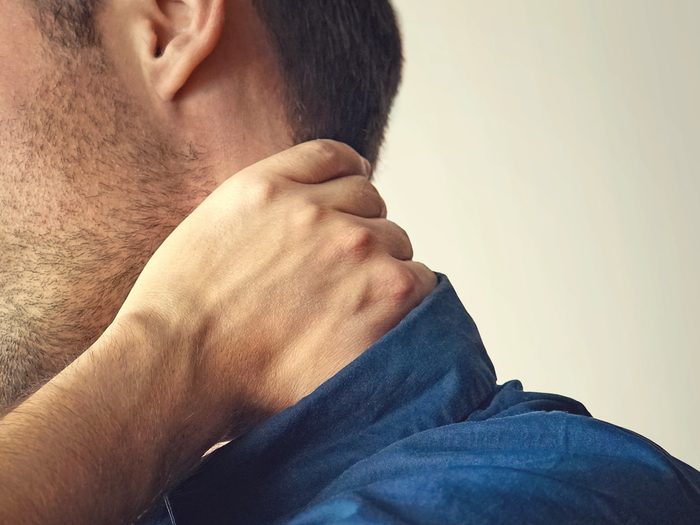
Your neck looks dirty
A rash-like discolouration called acanthosis nigricans “almost looks like dirt but has a velvety feel,” says Todd Sontag, DO, a family medicine specialist with Orlando Health Physician Associates. He commonly sees it on the back of the neck or in the armpit. This is often a sign of diabetes or insulin resistance. “Patients will come in asking about this rash they can’t get rid of,” he notes. A doctor will order blood tests to check blood sugar levels to make the diagnosis.
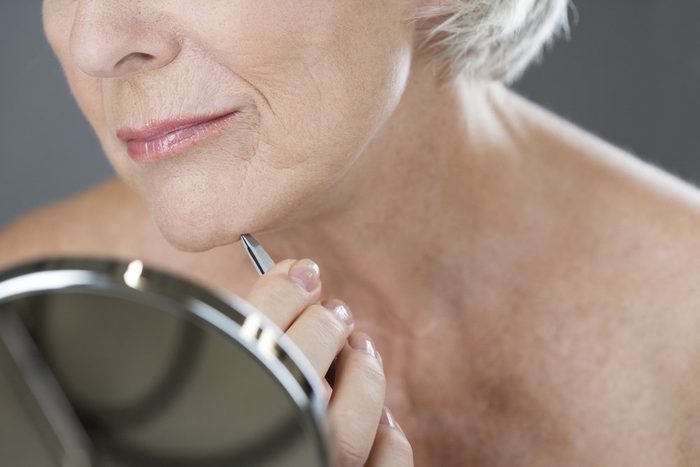
You’re a woman and you’re sprouting chin hairs
This can be a sign of polycystic ovary syndrome, notes Dr. Sontag. “Usually you see just a few hairs, but they’re dark and coarse like a man’s beard,” he notes. The hormonal imbalance may also affect your period, and can thus impact your fertility. A look at your medical history and symptoms can point your doctor in the right direction. Here are more signs of polycystic ovary syndrome.
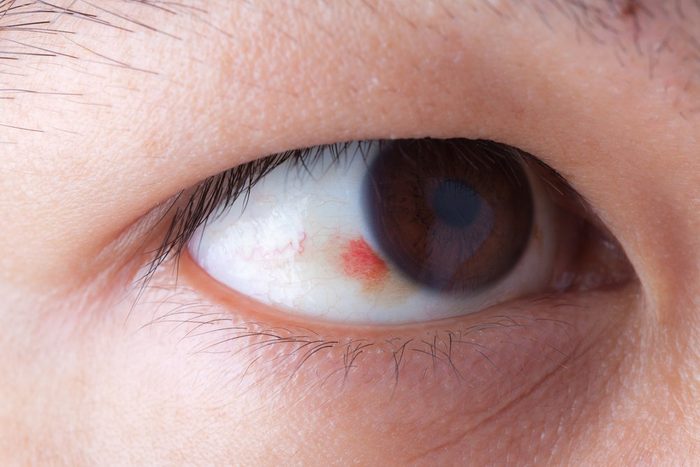
You see blood spots in your eyes
The condition is known as a subconjunctival hemorrhage, and the American Heart Association notes that this is more common with people who have high blood pressure or diabetes. While these conditions don’t cause the spots, the two are linked, they note, which gives you yet another reason to visit the eye doctor every two years.
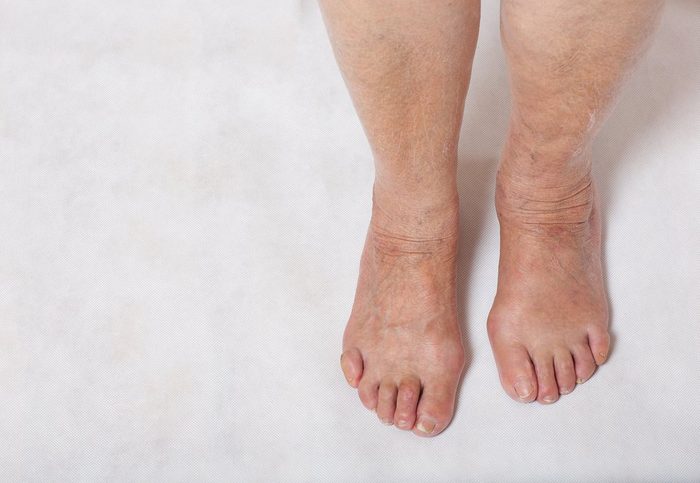
Your big toe is swollen
You don’t remember stubbing it—and it’s not like you’d forget. You could be looking at an early symptom of gout, which is not only painful but can signal risk for chronic diseases like high blood pressure and kidney disease. A medical history plus examination at the MD office can diagnose it. Don’t miss these signs of an infected cut or scrape that you should never ignore.

You have a major hankering for ice
Occasionally, a patient will come see Dr. Sontag and say “all I want to do is eat ice all day,” he notes. That’s a sign of iron-deficiency anemia. You’ll need a blood workup, and your doc will want to figure out why you’re anemic—are you losing blood or not making enough? The answer will direct your care, he notes. Here are some surprising facts about iron deficiency you’ll want to know.

Your eyes are bulging
If this is something that seems new—in pictures from last year they look normal—it could be an overactive thyroid, says Dr. Sontag. You may also notice other symptoms like unexplained weight loss or irritability. A thyroid blood test will ID the problem. Iodine treatment can slow your thyroid, and you can manage the issue with thyroid medications. However, Dr. Sontag notes that sometimes thyroid problems are self-limiting and resolve on its own. Here’s more on how to tell if you have a hidden thyroid problem.

You’ve gotten shorter
If you’re wondering how your jeans got longer, you could be witnessing one of the silent signs of osteoporosis. As your bones weaken, the vertebrae in your spine begin to compress and you start to lose height. If you’re 1.5 inches shorter than you were in your 20s, see your doctor. Here’s how to prevent osteoporosis.
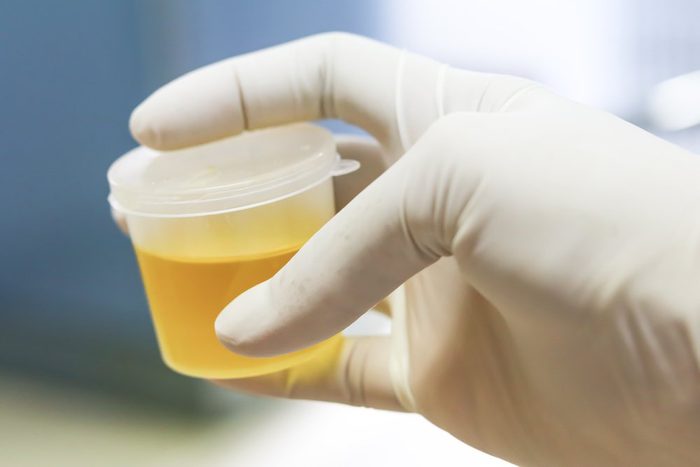
Your urine is cloudy
When you pee, it should be clear and the colour of light lemonade. If it’s darker yellow, you could be dehydrated; when it’s almost clear, you may be too hydrated. But if it’s cloudy or very dark, you could have a bladder stone that’s irritating the wall of your bladder. A physical exam and urinalysis can pinpoint the issue. Visiting the washroom a little too often? Here are 7 medical reasons why you might need to pee all the time.
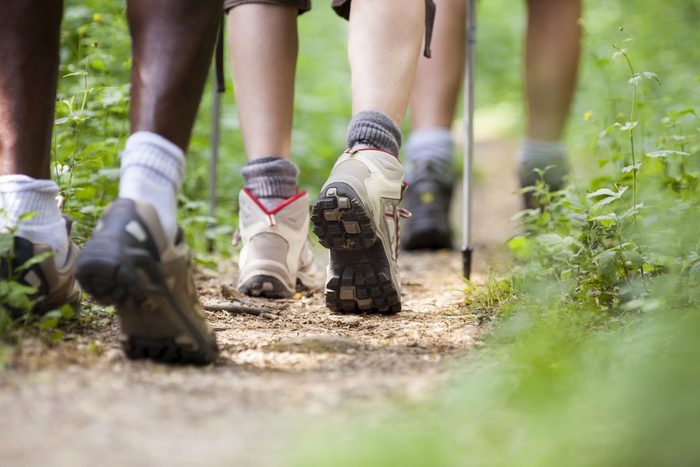
Your feet feel like they’re attached to bricks
This could be a sign of rheumatoid arthritis (RA), a condition that hits women more than men and often strikes those between the ages of 20 and 40. Fatigue (with or without joint pain) is another common symptom. Feeling stiff for four weeks warrants a trip to the MD to make sure everything is OK.
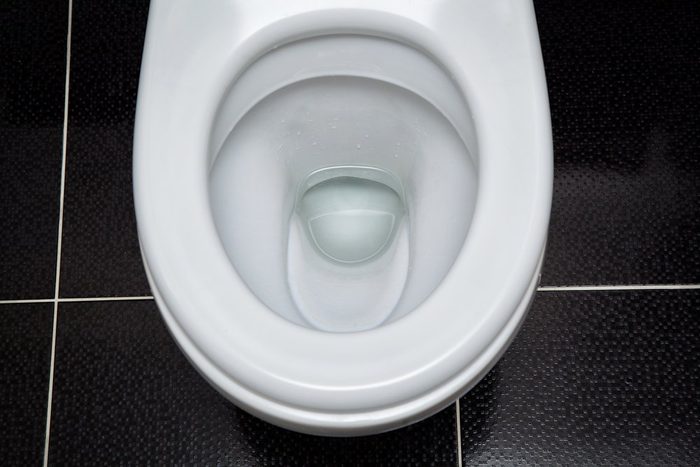
Your stools are black
No doubt it’s an alarming sight, but there are a couple possibilities: One, you’re taking Pepto Bismol, which can turn them black. Two, the colour can be a sign of digested blood, in which case your doctor may consider more serious issues like a stomach ulcer or GI cancer. Here’s what your stomach could be trying to tell you.

Your stools are green
Yikes! Green poop certainly gets your attention. “This is often some sort of infection, like giardia or salmonella,” says Dr. Sontag. Your doctor will ask whether you’ve been abroad or camped or hiked recently and then consider testing.
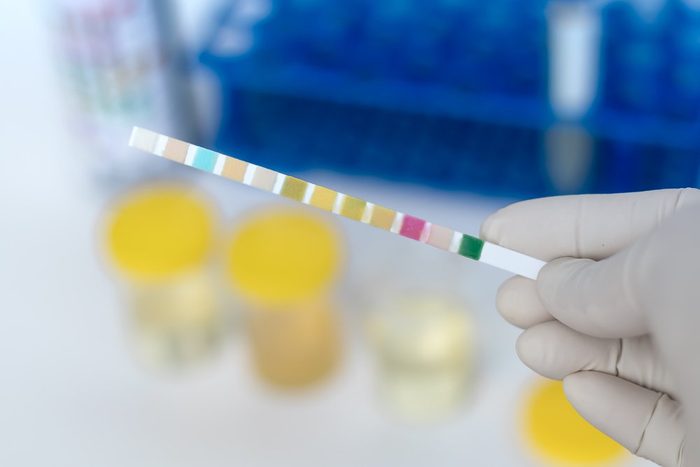
Your pee looks pink
Pink or red pee is a sign of blood in your urine. The most likely causes are a urinary tract or kidney infection, but it can also be present in later stages of kidney, bladder, or prostate cancer, notes the Mayo Clinic. A urinalysis will be used, in part, to uncover the cause of the bleeding. Here are 15 signs of a UTI you should watch out for.
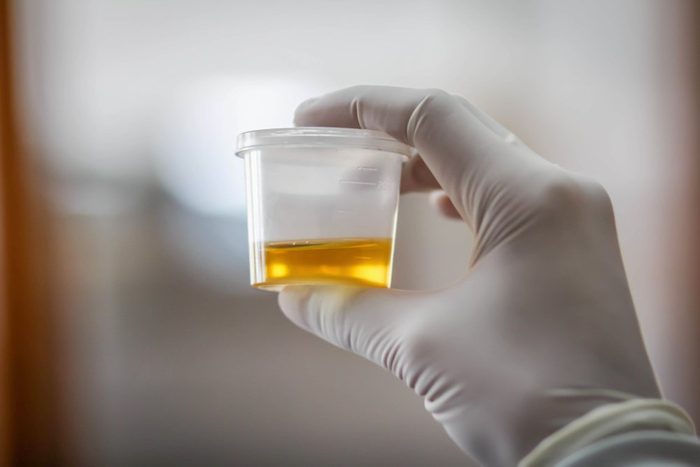
Your pee looks like cola
This should set off immediate alarm bells—particularly after an extreme workout or, say, running a marathon. It could be rhabdomyolysis, which happens when muscle tissue breaks down, enters your bloodstream, and causes kidney damage. This serious disease warrants a trip to the ER.
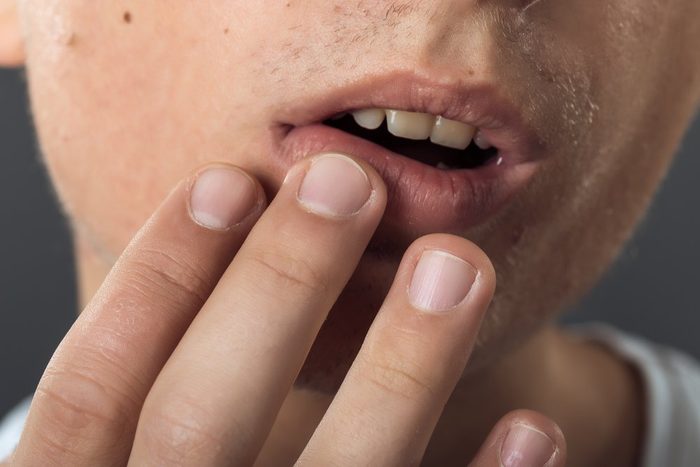
Your mouth is burning
Appropriately called “burning mouth syndrome,” this may be due to damage to pain and taste nerves. You’ll notice a painful burn or tingle in your mouth that’s frequent and sticks around for months. While there’s no test to diagnose this problem, your doctor will do a thorough workup to rule out other potential causes and may give you a prescription that can ease your discomfort.
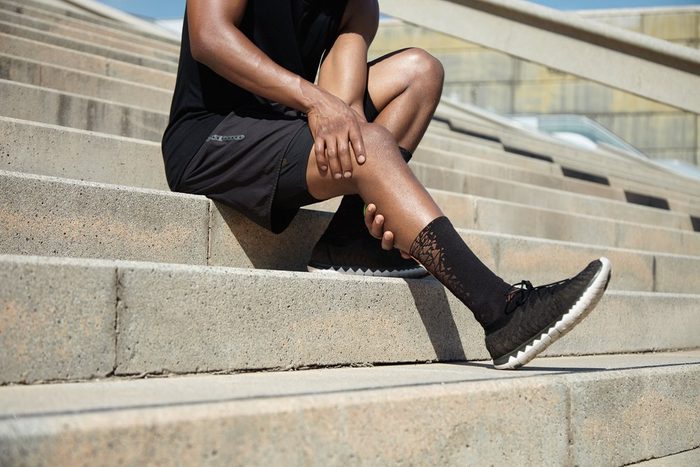
Your leg hurts when you walk
Certainly, the first thing you want to think about would be: Did I injure myself on that hike I took last weekend or did I overdo it running more miles than I should? However, if the pain can’t be linked to an injury and it feels like your actual bone is hurting, it may be bone cancer (even if the pain comes and goes). Talk to your doctor about getting a biopsy. Be sure you know the different types of leg pain and when you need to take it seriously.
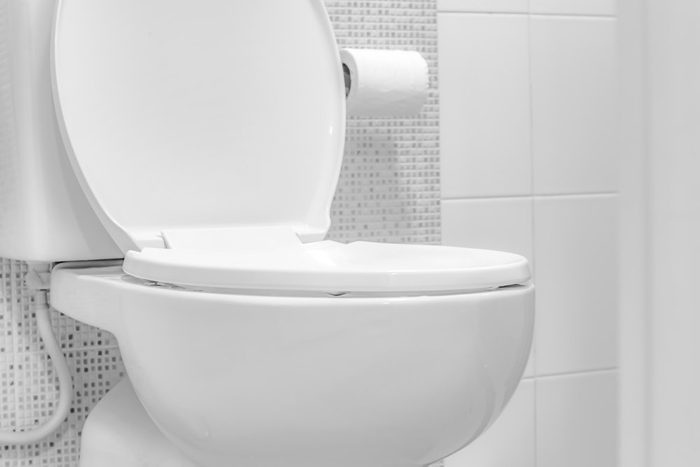
You pee all the time
Yes, an increase in bathroom visits can be because of a urinary tract infection—though UTIs usually have that tell-tale burn. However, if you pee constantly and have an unquenchable thirst, you may be developing diabetes, notes Dr. Sontag. If you notice that you’re going much more frequently than before or are waking up throughout the night to relieve yourself, talk to your doctor. Watch out for these 12 other signs you could be borderline diabetic.

Your nipples are leaking
Not breastfeeding? Not having sex? Then it may be a condition called galactorrhea. It could be an underlying medical problem like a prolactinoma, a benign tumour on your pituitary gland. While not always harmful on its own, the tumor can lead to irregular periods and interfere with your fertility. Blood tests can help your doctor uncover the underlying cause of your leakage.

You sit down to watch TV and immediately snooze
What seems like a commonplace event—it was a boring show anyway!—can mean something more: Most notably, sleep apnea. “I diagnose this a few times per week,” Dr. Sontag says. It’s more than an issue of disruptive snoring, he says: “Some patients hold their breath when they sleep for two minutes at a time. You’re not getting enough oxygen throughout the night,” he says. Sleep machines have come a long way; they’re smaller and quieter today. Don’t be afraid to talk to your doctor if you snore, feel unusually tired throughout the day, or your partner says you stop breathing at night. Snoring is no joke: Here are some signs of sleep apnea you might be missing.

You wake up exhausted
This can be a sign of restless leg syndrome, or RLS. “You wake up tired because your body has never fully relaxed at night,” says Dr. Sontag. You may also have a strong urge to move your legs that gets worse when you’re sitting down. An evaluation of your medical history and symptoms can help point your MD in the right direction.

You gained 20 pounds this month
Many people blame their weight gain on a sluggish thyroid—after all, this butterfly-shaped gland at the base of your neck helps control your metabolism. But a slow creep in weight is less likely with a malfunctioning thyroid than sudden weight gain—like 20 pounds in a month—says Dr. Sontag. Either way, your doctor may want to do a thyroid blood test to rule out the condition. Don’t miss these 15 signs your weight gain means your health is in trouble.
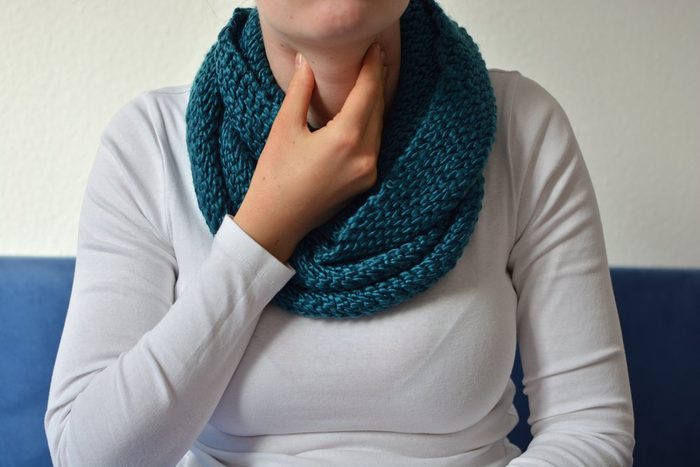
You swallow and something feels stuck
If you frequently feel like food is caught in your throat or find yourself changing the way you eat (like taking baby bites or avoiding certain bulky foods), this may be a sign of esophageal cancer. A medical history and physical exam can tell your doctor if it’s a possibility. If so, they may order an imaging test to check for cancer.

Your breast skin is nubby like an orange peel
Dimpled skin may be a sign of underlying breast cancer, says Dr. Sontag. “The orange peel look comes from swelling,” he adds and may be caused by inflammatory breast cancer. (The term is called “peau d’orange.”) A physical exam will be up first, and your doctor may examine breast tissue through a mammogram or ultrasound.
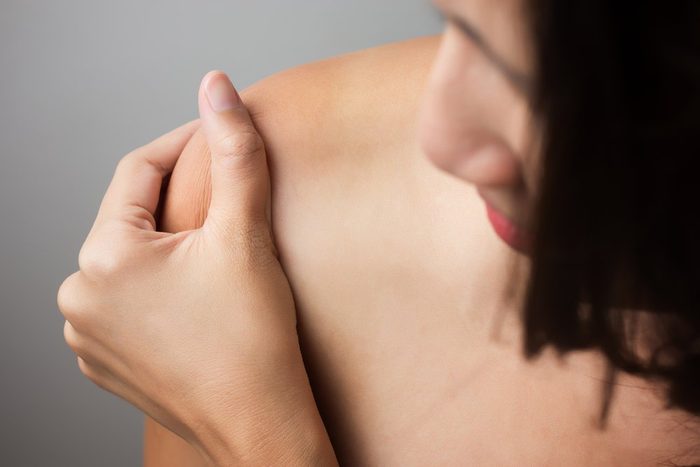
You have a lump on your shoulder
Oddly enough, developing a lymph node on the top of your left clavicle can be a sign of stomach cancer, says Dr. Sontag. (This is called Virchow’s node.) If you notice any strange lumps or bumps that have recently appeared, call your doctor. Concerned about a skin bump or lump? Here’s when to worry – and when it’s normal.

You have a lump around your belly button
A soft bulge around this area may be what’s called an umbilical hernia. But you’re right to get it checked out by your doctor: It could also be a lymph node called a Sister Mary Joseph nodule, and a sign of underlying cancer, says Dr. Sontag. “Sometimes your body is doing what it should, and it’s OK to have lumps. But any time you notice anything unusual that’s changed, it’s always worth getting checked out,” he says.
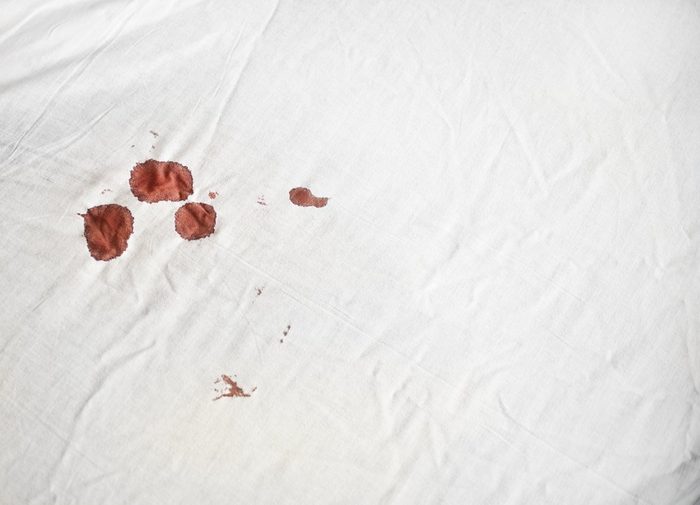
You’re bleeding after menopause
Light spotting isn’t anything to be worried about—in fact, it’s often normal. But period-like bleeding warrants a trip to your doctor who may be concerned about uterine cancer. Early diagnosis is key: Women diagnosed in stage 1 have a five-year survival rate of 88 percent. Here are the other cancer symptoms women are likely to ignore.

You have a new spot on your skin
You know to look for changing moles that are irregular in shape, size, or colour, but a new one that pops up should raise your suspicion even more. A new study in the Journal of the American Academy of Dermatology found that 70 percent of melanomas arose from a new mole, while only 30 percent sprang from an existing one. Talk to your derm about any new skin spots, and get an annual skin check to make sure your body-wide complexion is in the clear. Protect your skin with the latest in sun protection.

You’re really bloated
Beyond simply eating too much sushi (hello, soy sauce) or expecting your period any day now, abnormal and uncomfortable bloating can be a sign of ovarian cancer. You may also pee more frequently, grapple with pelvic pain, or experience pain during sex. If your doctor suspects ovarian cancer, they will first run a physical exam to look for things like an enlarged ovary. If you often struggle with bloating, you might want to adopt these nine daily habits that can relieve the pressure.
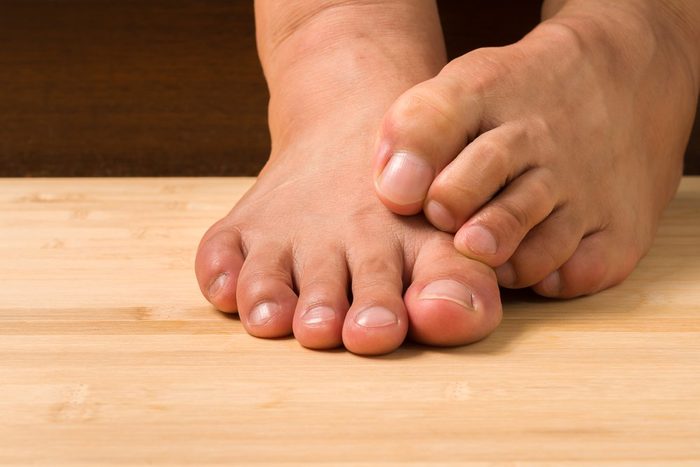
Your feet are itching like crazy
Are you pregnant? A liver disease called cholestasis of pregnancy can cause severe, drive-you-batty itching on your hands and feet. It’s rare, but something to watch out for: While mom isn’t at risk (except for the itching), it can be dangerous for the baby; it increases the likelihood of complications like preterm delivery. Inducing labor may be one option your OB/GYN will consider.

Your skin itches all over
There’s another cause for itchy skin not related to pregnancy—liver damage called cirrhosis. As the Canadian Liver Foundation points out, early damage to the organ often carries zero symptoms. Later you sufferers may experience itching or a yellow cast to their skin, called jaundice. Luckily, after diagnosis, you can prevent further damage by eating healthy and exercising.

You’re bleeding after sex
If your first thought is, well, we haven’t done that in a while, hang on: Bleeding after sex isn’t typical. There are a host of potential causes—ranging from vaginal dryness to cervical polyps—but cervical cancer also falls on that list. While it may be frightening, it’s important to bring it up with your MD who will consider a range of causes and work to rule out cervical cancer. This is also why it’s important to get a regular pap test.
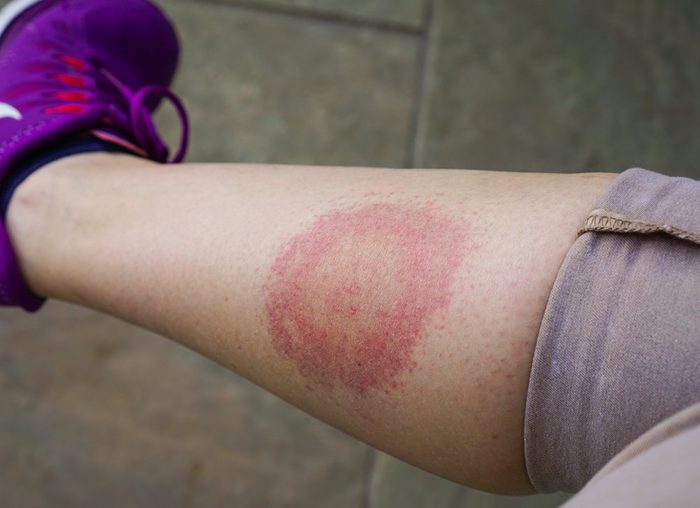
You develop a bulls-eye rash
If you see a red rash in the shape of a bulls-eye popping up on your skin, you should immediately call your doctor. The first thing they’ll check for is an autoimmune disease called Lyme disease. Caused by a tick bite, the disease can also cause more sneaky symptoms like fatigue, lack of focus, and a sore throat. While some people develop a rash, it may also take on various shapes and colours, like multiple rashes or may even have a blue hue. If you notice these symptoms or anything out of the ordinary after spending time outside where Lyme-carrying ticks live, talk to your doctor. Here what you should know about Lyme disease in Canada.
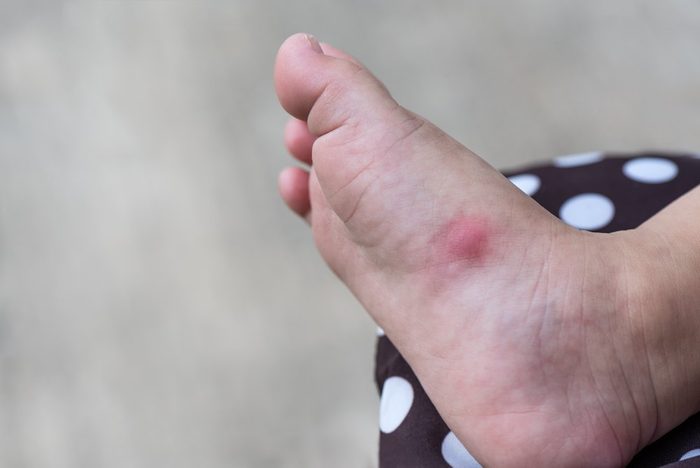
You have a red, splotchy rash on your feet
Lyme isn’t the only tick-borne illness you have to watch out for. Rocky Mountain Spotted Fever, caused by the bacteria Rickettsia rickettsii, can be life-threatening. You may notice non-descript symptoms like a fever or a headache (which can be chalked up to the flu), but most many patients will also develop a red splotchy rash starting from their ankles and wrists and moving up the body. If you get sick after hiking or camping, call your doctor.

You don’t feel… right
Yep, this is really vague, but weird, vague “something isn’t right” symptoms should set off alarm bells—possibly for a heart attack. Women don’t always get the classic chest pain symptoms of a heart attack; it can manifest as more silent signs like feeling tired, upper back pain. “With anything out of the ordinary that suddenly pops up without a clear explanation, it doesn’t hurt to have a heart attack in the back of your mind,” says Dr. Sontag. Call your doctor or go to the ER.
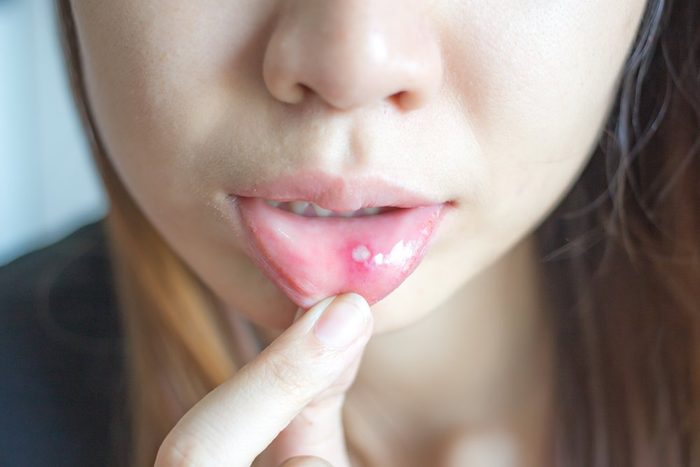
You can’t get rid of those canker sores
With so many symptoms of celiac disease (300!), diagnosis can be difficult. And while GI issues like diarrhea, constipation, and bloating are common, so too are more head-scratching ones like canker sores, reports Beyond Celiac. You may notice these in your cheeks, gums, or lips, and they can be painful. While it’s not a slam dunk for diagnosis, also watch out for other symptoms of celiac, like mood problems, joint pain, and infertility.
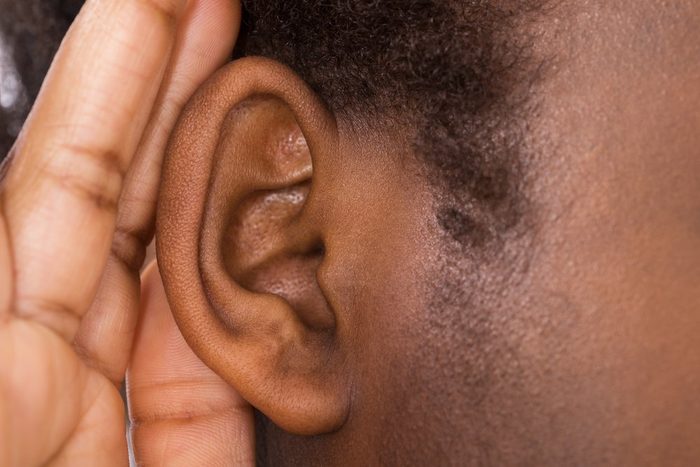
You can’t hear well out of one ear
If you’ve been hearing ringing or sounds are muffled in one ear, you may have an acoustic neuroma, a rare, non-cancerous and often slow-growing tumor, according to the Acoustic Neuroma Association. That’s not to say it’s not dangerous. As it grows, it can cause balance problems and even be life-threatening. If your doctor suspects this, an MRI can confirm the diagnosis. Read up on these 8 things your ringing ears are trying to tell you.
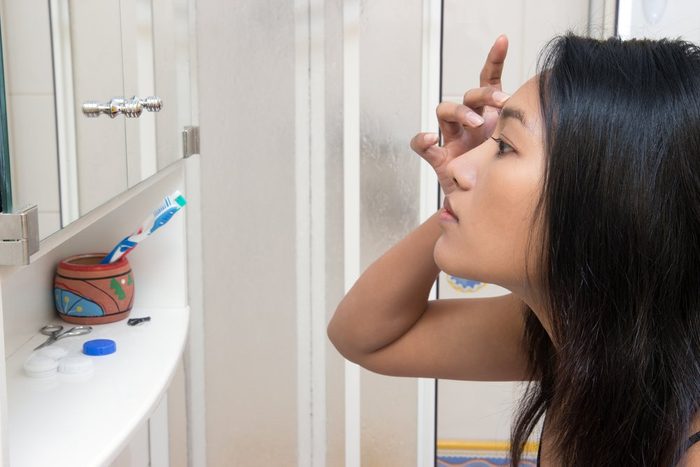
Your eyebrows are thinning
And you thought you just didn’t have to pluck them anymore. Hair loss, including from your eyebrows, can be a sign that your system is working sluggishly thanks to an underactive thyroid (also called hypothyroidism), says Dr. Sontag. Watch out for other symptoms like feeling cold all the time and constipation. Again, your doc will want to run a simple blood test to evaluate the function of your thyroid. Here are some other signs that you should get your thyroid levels checked.
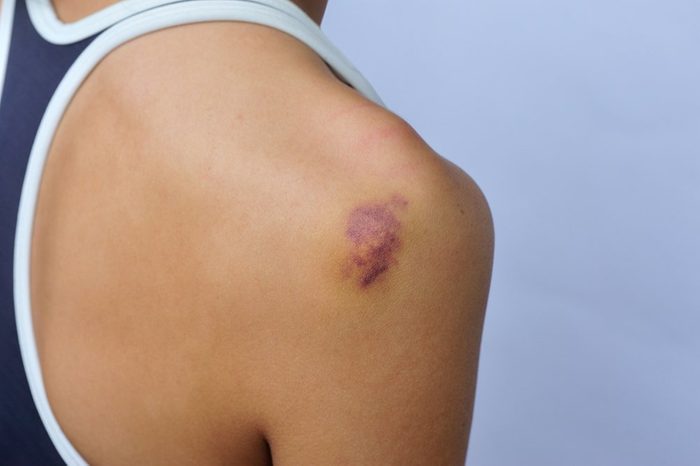
You bruise easily
When you look down, suddenly you see a bunch of discolourations dotting your legs. Have you just been extra clumsy? Maybe, but it can also be leukemia. Low blood platelet counts can make you more susceptible to bruises, notes the Canadian Cancer Society. Of course, this doesn’t have to be your first worry, but if your doc suspects a problem, they will check your blood cell count before more invasive testing, like taking a bone marrow sample.
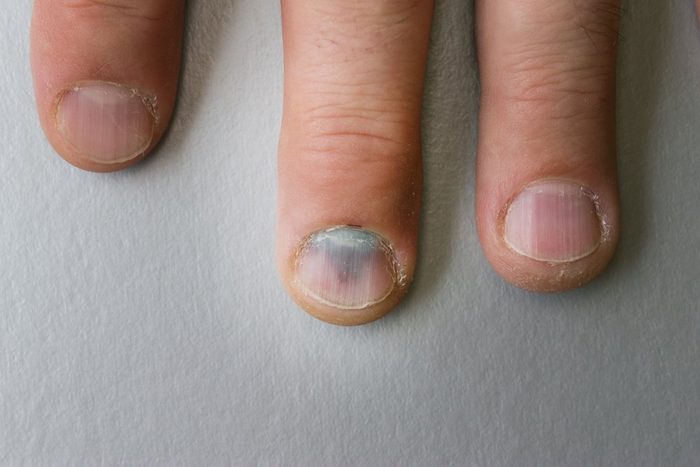
You notice a black streak on your nail
The primary place you likely suspect skin cancer is, well, your skin, but it can also appear on the skin of your nailbed, too. Called acral lentiginous melanoma (ALM), this type of skin cancer can look like a dark streak under your nail. If you don’t know what caused it (like smashing your finger in the door) and it’s recently appeared, see a dermatologist for an evaluation. Here’s what it means if you have white spots on your nails.
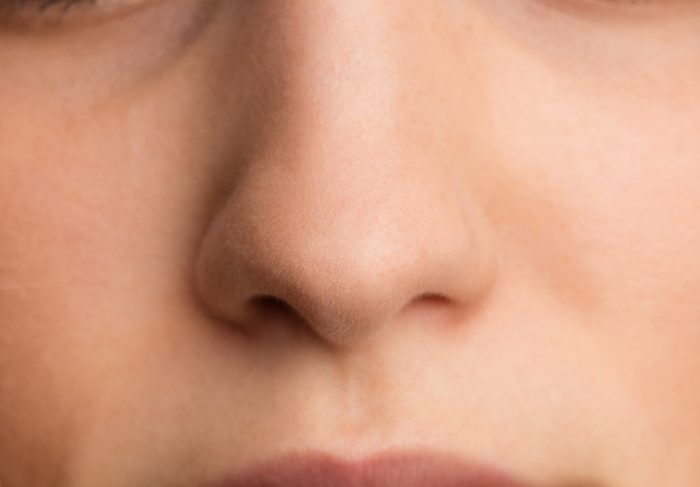
Your sense of smell is dull
If your nose doesn’t perk up to various smells, your ears should perk up to the possibility of an increased odds for Alzheimer’s disease, at least according to one new study published in Neurology. Three hundred people who already had a parent with the disease (and thus were considered higher risk) were asked to take scratch-and-sniff tests (scents varied from lemon to gasoline). People who weren’t as sharp odor identifiers also had markers of AD. Of course, this isn’t enough to diagnose you. If you’re worried about your risk, particularly if you have a family history of the disease, talk to your doctor.

Your child has sudden OCD
Surprisingly, it may be one of several strep throat symptoms. If you have a little one who had a round of strep throat and has suddenly developed obsessive-compulsive tendencies, the culprit may be the group A Streptococcus infection. It’s a condition called PANDAS, or “pediatric autoimmune neuropsychiatric disorders associated with streptococcal infections.” Along with OCD, they may also develop anxiety, aggression, or ADHD-like symptoms. It can be a difficult road to diagnosis, but there are several treatment options available. Talk to your child’s pediatrician if you notice an abrupt and alarming change in their behaviour and personality.
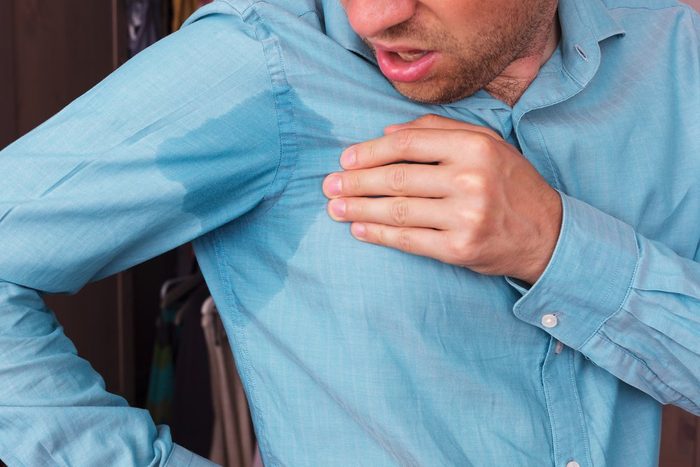
You’re sweating through your clothes
Excessive sweating, often on your hands, underarms, or face is called hyperhidrosis. The sweat itself is harmless (though it can be life-altering), but it can also be an indication that an underlying medical condition is responsible for the extreme wetness. Among other causes, like a side effect of medication, non-Hodgkin lymphoma is one of them. Along with the sweat, you may experience fever, weight loss, or shortness of breath. If your doctor thinks it may be lymphoma, they’ll order a biopsy of any enlarged lymph nodes to confirm or rule out the diagnosis.
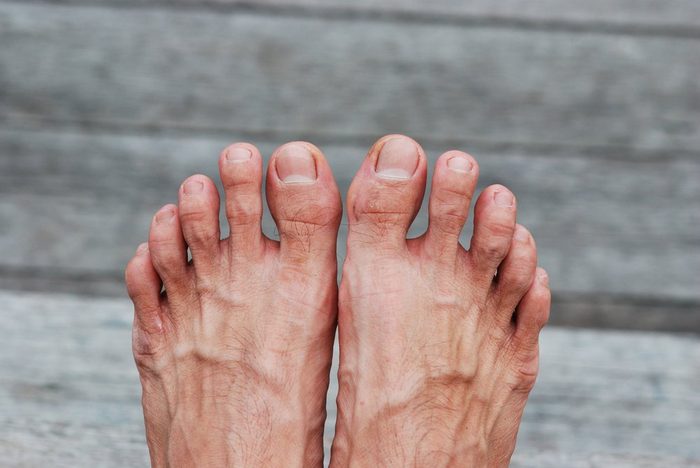
Your toenails aren’t growing
It may be convenient, but if you can’t remember the last time your toenails needed a trim, it’s time to ensure something else isn’t going on. Slow growing toenails or leg hair, or foot wounds that don’t heal as they should, are all signs of peripheral artery disease (PAD). These are clues that blood flow is having a tough time reaching your lower half because of plaque buildup in these arteries. Tell your doctor about any of these off-kilter symptoms; they may want to check the pulses in your legs to make sure all is functioning as it should. Next, find out the health secrets your hands are trying to tell you.
